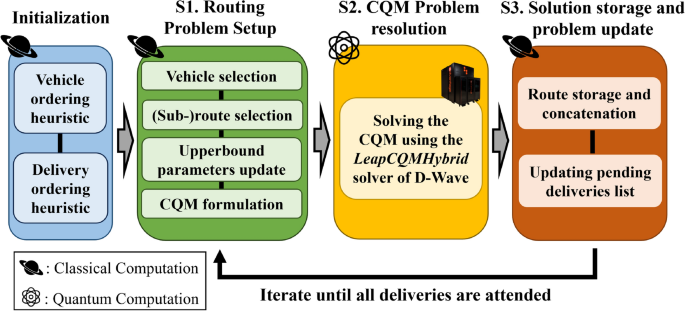Researchers have developed a groundbreaking quantum-classical system called Quantum for Real Package Delivery (Q4RPD) that can solve complex real-world logistics problems. The system tackles a challenging package delivery routing problem with constraints like a heterogeneous fleet of vehicles, priority deliveries, and package dimensions. By combining classical computing and quantum annealing, Q4RPD can efficiently find optimized routes that minimize costs while satisfying all the requirements. This research represents a significant step forward in applying quantum computing to solve practical problems faced by logistics and transportation companies. The findings could have far-reaching implications for improving the efficiency and sustainability of last-mile delivery services.
Tackling the Complexity of Real-World Logistics
Routing problems are notoriously difficult to solve, often classified as NP-hard problems. Traditional computers struggle to find optimal solutions, especially for large-scale, real-world scenarios with numerous constraints. This is where quantum computing emerges as a promising alternative, offering the potential to unlock new levels of efficiency and problem-solving capabilities.
The research team, led by Eneko Osaba, Esther Villar-Rodriguez, and Antón Asla, recognized the need to bridge the gap between theoretical quantum computing research and practical real-world applications. They set out to develop a quantum-classical hybrid system that could tackle a complex package delivery routing problem faced by a Spanish logistics company, Ertransit.

Introducing the Quantum for Real Package Delivery (Q4RPD) System
The Q4RPD system combines the strengths of classical computing and quantum annealing to solve the 2-Dimensional and Heterogeneous Package Delivery with Priorities (2DH-PDP) problem. This problem involves finding the optimal routes for a fleet of heterogeneous vehicles to deliver packages, while considering factors such as:
– Capacity constraints (weight and dimensions)
– Priority deliveries with strict time windows
– Restrictions on driver working hours
The researchers developed a novel solving scheme that iteratively calculates individual routes or sub-routes using a quantum annealer. The classical computing component of the system handles the overall workflow, including splitting the problem into manageable sub-problems, providing the necessary resources, and ensuring the final solution meets all the constraints and preferences.

Unlocking the Power of Quantum Annealing
The key to Q4RPD’s success lies in its ability to leverage the intermediate-scalequantum’>NISQ-era quantum computing literature.
Paving the Way for Practical Quantum Applications
This research represents a significant milestone in the application of quantum computing to real-world optimization problems. By developing a hybrid quantum-classical system that can effectively solve a complex logistics problem, the team has shown the potential of quantum computing to transform the transportation and logistics industry.
The findings of this study have several important implications:
1. Bridging the gap between theory and practice: The Q4RPD system demonstrates how quantum computing can be successfully applied to solve realistic problems faced by businesses, moving beyond the traditional “toy-size” problem instances often seen in the literature.
2. Enhancing logistics efficiency and sustainability: The ability to optimize package delivery routes can lead to reduced transportation costs, lower emissions, and improved customer satisfaction, contributing to more sustainable and efficient logistics operations.
3. Paving the way for future quantum applications: This research serves as a model for how quantum computing can be integrated with classical computing to tackle complex, real-world problems in various industries, from healthcare to finance and beyond.
As quantum computing technology continues to evolve, the insights gained from this study will undoubtedly inspire further advancements in the field and accelerate the adoption of quantum-based solutions in practical applications.
Author credit: This article is based on research by Eneko Osaba, Esther Villar-Rodriguez, and Antón Asla.
For More Related Articles Click Here
